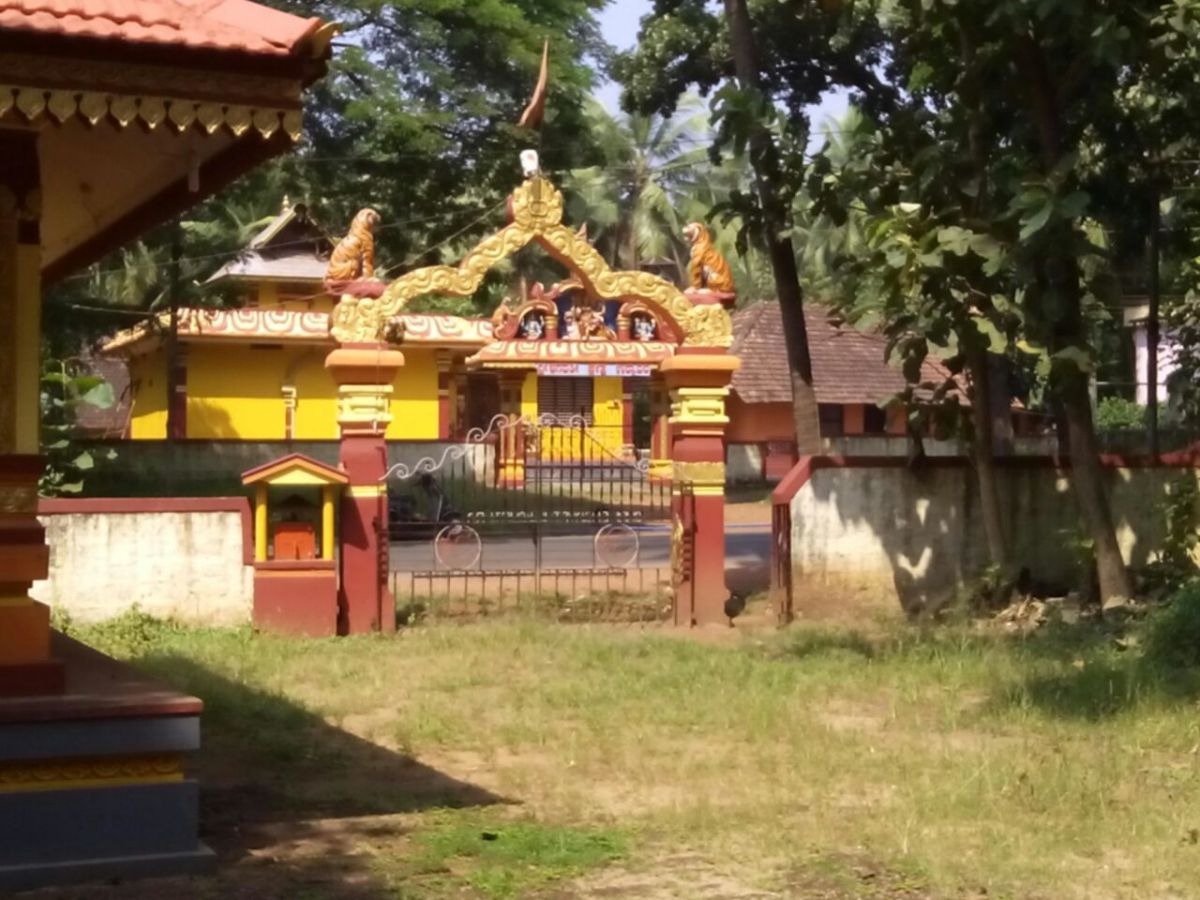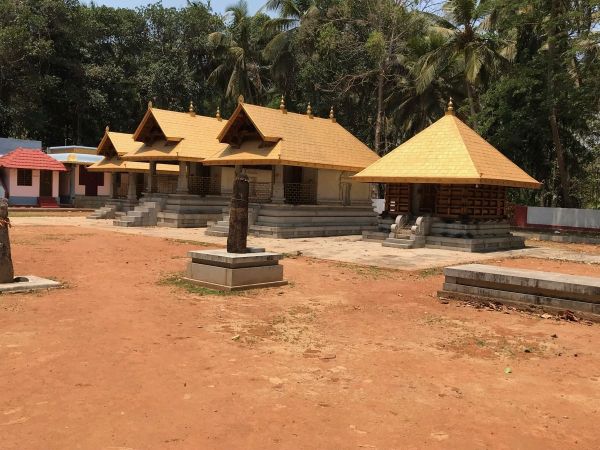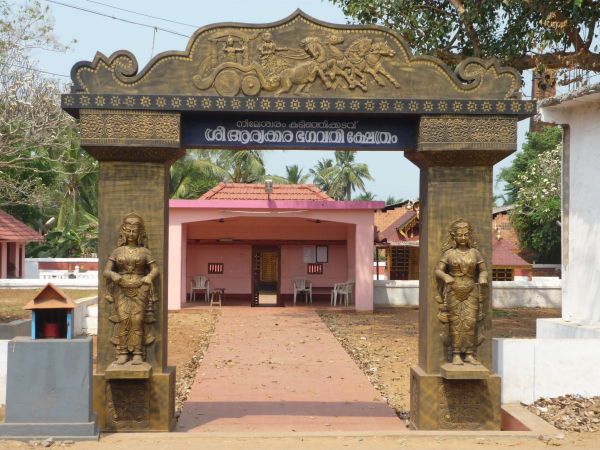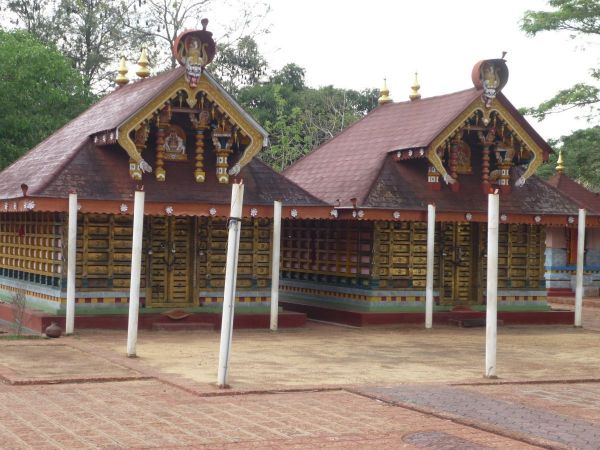Udyawara and Adka Shree Bhagawathi Sthanams are considered to be twin sthanams. The bonding of these sthanams have been compared in numerous ways by the Daivas. These sthanams are like the two eyes of the same face, two houses in the same compound and like the pillars of the same well. Udyawara sthanam is called 'Aadi Udyawara' and Adka sthanam is called 'Anaadi Adka'. It is historically believed that Paadangare Bhagawathi and the fourteen daivas arrived at Adka sthanam from Udyawara. The methods of implementation in both the sthanams are almost similar.
Udyawara Bhagwathi Sthanam is located towards the Northern border of Kasargod district in Kerala. It is approximately 15km from Mangalore towards South and close to the National highway.It is situated to the North of the culturaly significant 'Udyawara Arasudaiva Mada' in Udyawara.It is surrounded by Kunjathur Mahalingeshwara temple, Hosabettu Keertheshwara temple, Badaaje Mahalingeshwara temple, Kanila Bhagawathi Kshetra in Bangra Manjeshwara and the Kanwatheertha mutt.
In the words of the Bhagawathis, villages that came under Udyawara sthanams were called ' Chedho jand naad'( a village divided in into two). These divisions were called 'Kudhurme'; the three divisions being Ballangotu, Kolake and Kuchikaadu. It is believed that the land where the temple was built was owned by Ballappanayak which he gave up later.
The Bhandaara Chaavadi of the main temple and the other temple is situated in the well- known place called 'Patthanmilekal'(10th milestone) near the National highway. Bhandaara Chaavadi faces towards the North and the other temple faces towards the South. Few meters away from the National highway, towards the West, is the temple of the main deity.
Initially there were four sthanams for the deities- Paadangare Bhagawathi, Aamutti Bhagawathi, Betaikurumagan and Veerammar, two temples for Guliga , a katte for Babbarya.
In the year 1992, the walls of the temple were burnt as an impact of communal riots that took place due to the destruction of Baabari Masjid in Ayodhya.
In the year 1996 when the temple was renovated, a sthanam for Vishnumurthy deity was constructed as per the Ashtamangala queries.
This place is not only culturally diverse but also a strong connection has been established among the Bhagawathis, Udyawara Arasu Daivas and Bangra Manjeshwar's Babbarya temples. Also, the relationship among them have been grown strong over years. Involvement of Muslim brothers and sisters in the annual celebrations is one of the highlights.
The first group of people who settled in Udyawara were the Sekamars( Muslim scholars) and then the Bhagawathis, followed by the Arasudaivas. When the Arasudaiva brother duo came here, there was Muslim administration. When asked for a place to stay, they had suggested to take shelter in a place where their arrows would land. As a symbol of unity between the Sekamars and the Arasudaivas, every year before the annual festival, on a Friday afternoon, the Arasudaivas would visit the Sekamars in a procession. By then, the Muslims had to finish their Namaz( prayers) and Jamaath as nobody was allowed to be around during their meeting.
There is a belief that once a person had tried to overhear their conversation and did not come out alive. The reason of this meeting could be an invitation to the annual celebration or thanking an ordinary Muslim warlord. During the 'Koliguta' of the annual celebration, the gurikars were supposed to buy the coconuts, arecanut and beetel leaves from the flea markets kept by some specific Muslim families. This was done to signify 'Kacchoda' (business) custom. Also, during the celebration Muslims were supposed to sit on the 'Simhasana katte'which symbolized 'respect'. This act of communal harmony must be a result of some historical event taken place long ago.
As an agreement between the Bhagawathis and the 'Poodhamar' (arasudaivas), inside the elder daiva's maada in the Southwest, there is a ladder like conical figure in which rests a pillow probably for the Bhagawathis. It is like a forum representing the Gods inside the 'garadi' or 'kalari'. Hence there is a belief that Mada could be a garadi itself. Arasudaivas are offered Naivedya and even the Bhagawathis are offered Deepa naivedya.
From ancient days, during the annual festival of Arasudaivas, the devotees of the Bhagawathi temple take part in three celebratory rituals: Kurikala(fixing the date for the annual festival), raising the kodi(dhwajarohana/flag hoisting) and carriage pulling. Meanwhile the priests of the Bhagawathi temple would get ready for darshana and express their views on the spot. Sometimes, matters related to justice were also discussed. Arasudaivas and the Bhagawathis would then execute various activities through mutual understanding.
Udyawara Mada has two carriages. The privilege of pulling the carriage with the elder daiva( elder brother) was given to Udyawara Bhagawathi Sthanam and the carriage of the younger daiva would be pulled by the Someshwara sthanam( now this custom does not exist).
The reason for the Bhagawathis to settle in Udyawara is a Moya woman's immense devotion. When a Kodkatt Moya Kutumba's woman had witnessed the celebration of a Theeya community in Padathur, she was mesmerized. She thought to herself, ' It would be so nice to have these Devis( bhagawathis) in our tharawad too'. It is said that, impressed by her devotion, the Bhagawathis came with her spiritually and stayed in her tharawad( the story of devotion of two Saadhvis belonging to Belmath moya kutumba which made the Bhagawathis come to Adka from Udyawara is another instance). Later,the Bhagawathi Aaradhane was carried out by the Moya Sabha in Udyawara. Initially it was Kodkatt Moya Kutumba which started the worship of Bhagawathis. Thus, all the divine activities related to Naga aradhane is done by them.
There is another story on how the Bhagawathis settled in Udyawara. When the Bhagawathis asked Lord Mahalingeshwara for a place to live, the response was ' You can settle in Udyawara provided you visit me every year with bhandaara.' The Bhagawathis agreed upon the same and lived there. ( According to the ancient system, without the permission of the main deity of a place, other deities could not live independently. The control of the Vedic temples on other worship places is an example). However, no one is sure about this meeting. It might have occurred then.
The area between the Uppala and Manjeshwara streams is Bangra Manjeshwara and the spot near the sea shore is Kote Manjeshwara. There is a belief that the Ikkeri kings had built a Fortress of the castle. Beside the fort is the Babbaryagunda. The popular Babbarya daiva, the Bhagawathis and the Arasudaivas have a cultural relationship. It is said that the Bhagawathi asked Babbarya to remain near the 'Alive baagilu' as a watchman and only with her permission he allowed the Arasudaivas to enter. Even in the recent times, at Kodithale(Kote thale/ fortress head ), Kaliyaata festival is celebrated.For the Bhagawathi named Koteyamma( Kotlamma), Mudi utsav is celebrated. During this celebration, people from Udyawara Bhagawathi Sthanam and Arasudaiva Mada arrive. This function was funded by Badaaje Thanthri family. As per the order given by Paadangare Bhagawathi living in Badaaje Tharawad, Kaliyaata had to be held for 7 days.
The daiva impersonator for Babbarya is a person belonging to 'Vannan' community. He is decorated with white and red clothes, a belt, a hat, a wand etc. He would climb the fort and wait for Arasudaiva's 'Keerol' (procession). He had to climb and check if the procession has reached 16 times. The Keerolu would stop near the 'dhali' built beside the 'dhoodhu kala'. Babbarya would face them and then welcome. Along with Babbarya, the priests would also come near the door. The Aayudha( weapon) kept on the banana leaf inside, will be handed over to the priest by the Thanthri.
Then the priest gets possessed by the deity
The Vannan who wears the Bhagawathi Mudi will be ready. Then, the Mudi approved by the Arasudaivas is worn. Prior to this, the Vannan seeks permission with the priests and touches the Mudi thrice.Once the vannan wearing the Mudi invokes the deity to his body the weapon is given in his hands.
Here there is a system of carrying Kalasham too. It is carried by a person belonging to the Theeya community and takes pradakshina. He is called the kalashakara. The kalashakara will be in front of the person wearing Mudi.
Some say 'kokokoko' while throwing the flowers on them. In the ancient times, there were fourteen sutthubali( pradakshine). Since the Mudi was delicate and and higher chances of falling due to breeze, it was supported by 'Katthari'. After pradakshinas, the Bhagawathi would go near the balivedike and the Arasudaivas near dhudhukala. Then the devotees receive Boolya prasada.
Mudi utsava's prasada is distributed by the Bhagawathi. The darshana stops after thnaking Babbarya and Arasudaivas.
The speciality of Kodithale is the absence of sthanam unlike other places. There is no roof for the structure built there. There is a belief that Bhagawathi got it constructed through Babbarya and the ganas. But Lord of Kolyur turned into a cock and cried out loud which made Babbarya think its already dawn and hence had to stop the work. ( There are different stories explaining the same; there may be historical reasons which are picturized as spiritual reasons often)
Since the work wasn't completed because of the cock, the Bhagawathi furiously hit the cock and the impact is still seen in the temple bimba.
It is believed that as a result of this, the decorated bimba tilts during the annual festival.
The Thanthri brings the statue of the Bhagawathi covered in a piece of cloth from Badaaje to Kodithale for the festival.Very long time ago during the time of daivas, There wasthere was a person named in Badaja in Badaaje who belonged to the backward caste. He was a powerful worshipper of the bagavathis. Later that house was conquered by the Brahmins. The two Brahmins who lived there knew black magic and wanted to destroy the powers of Paadangare Bhagawathi for which they got cursed by her. To repent for this blunder, Thanthri's wife removes her Maangalya for a day, puts it around the neck of the statue that is taken to Kodithale( Such custom is seen even in other places. Ex: During Karaga utsava, the pries's wife has to remove her Maangalya and other things that symbolize her marriage and become a widow momentarily. When the priest returns from Karaga, he ties the Maangalya around his wife's neck.
Since Kaliyaata is celebrated annually in Kodithale, there is no custom of Kaliyaata in Udyawara Bhagawathi Kshetra.In the upper temple of Udyawara, Beerammar daiva's 'maada' bhagawathi sthanam is in the front and is called 'Edhuru maada'. It is said that this maada is related to Chakkakuta kutumba. Once upon a time, the Chakkakuta kutumba had their own 'Dhonifund' and some were quite wealthy. Once four to five children of the same mother had gone to fish at night.
But unfortunately a huge whale took away their net far. There was cyclone too which made the sea worse. Everyone in the village were scared. The boat didn't return on time. The mother of those fishermen went to the seashore and took a vow- 'If my children return just like a blooming flower without fading away, before touching the food,I will lay a foundation stone in front of Edhuru mada.'( Beerammar daiva was their dharmadaiva)
In no time, the sea became calm and her children returned safely.
In the presence of Achchammars and with the help of sculptors she initiated the masonry work in Edhuru maada and then ate her food. ( In the year 1996 during the redevelopment, edhuru maada was changed and was built along with the other sthanams.) Thus, Chakkakuta Kutumba has a separate sthanam in Udyawara.
The Udyawara and Someshwara Bhagawathi Sthanams have almost similar celebratory rituals. In Udyawara sthanam, Nadavali festival wasn't held annually. Recently, it happens every year. When the bhandaara from the lower sthanam goes to the upper sthanam, the daiva bimba is carried by the poojari on their head( whereas in Someshwar they hold it in hands). After the Nadavali festival, there won't be Annappa Panjurli Nema. On Vishnusankramana, daiva bimbas aren't carried to the upper sthanams( in Someshwar this custom is followed).
Image Source :MBSS
Contents Source : Bhagavathi Aradhane (Dr. Amritha Someshwar) & MBSS



